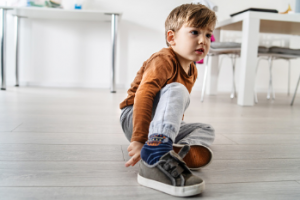Kids’ Shoe Size Guide
When buying kids’ shoes, the size should be based on the height of the foot, not the height of the child’s toes. It is because infants should have about a finger width of space at the end of their longest toe, and older kids should have about an index finger’s width. When shopping for kids’ shoes, it’s best to bring your child with you when trying on the shoes. This way, you can test the fit and have input on style and colour.
 When buying kids shoes, make sure to buy the correct size. Young children’s feet grow rapidly, and they should get a new pair of shoes at least three times a year. Depending on their weight, toddlers can grow one-half size every two to three months. Then again, a new pair is needed when they are three to four years old, and so on. Make sure you’ve taken your child to a shoe sizing store for a fitting.
When buying kids shoes, make sure to buy the correct size. Young children’s feet grow rapidly, and they should get a new pair of shoes at least three times a year. Depending on their weight, toddlers can grow one-half size every two to three months. Then again, a new pair is needed when they are three to four years old, and so on. Make sure you’ve taken your child to a shoe sizing store for a fitting.
When purchasing kids’ shoes, keep in mind that size does not mean that the shoe should be narrow; it should be a little longer than your child’s feet. Aim to buy shoes that have about half an inch of toe room. Also, make sure that the toe area creases when the child first steps. Breathable material and a cushioned insole are the best options for young feet. In addition, the heel cup should be stiff and will not slip over the heel counter.
Fortunately, the kids’ shoe size chart is easy to read. Select the size column and move your mouse horizontally along the line. When you find a size that fits, look for the corresponding number. EU and US sizes are the same as men’s sizes, but you should note that Italian shoe sizes are smaller than their European counterparts. Also, depending on the brand, conversions may differ. Buying kids’ shoes are important for your child’s comfort and safety, as shoes that are too large or too small can cause blisters or other problems.
There are several differences between the sizing systems in Europe and the U.S., but the same size will fit babies and children. It’s important to remember that girls’ shoes are generally larger than boys’, so be aware of this. Also, keep in mind that girls and boys may wear different sizes of the same size. To make sure you’re buying the right size, check the shoe’s label to make sure it matches your child’s age.
The feet of young children grow rapidly. Changing kids’ shoes for at least three to four months is recommended, although it may vary depending on the brand and model. The youngest children can grow half a size every two to three months. Even if the shoes have no visible signs of wear, you should consider buying a new pair if they show signs of limping or blisters. During these years, it is important to buy shoes that fit comfortably.
A good tip for buying kids shoes is to purchase one size bigger than your child’s shoe size. When purchasing shoes for a baby, you can measure your child’s foot and then compare it with a normal adult foot size chart to see which one fits your baby best. Always remember to consider the growth spurts and size differences. A good pair of kids’ shoes will make your child comfortable for longer periods and not leave irritation marks.
Kids’ shoe sizing charts are helpful for parents who aren’t familiar with the differences between the U.S. and European sizing systems. You’ll need to look for a sizing chart for your child’s shoes to find the right size for their feet. Most shoes are divided into three categories: toddler, preschool, and grade school. It means that a size 10C is smaller than a size 5Y, but a child that wears a size 5Y should be fine.